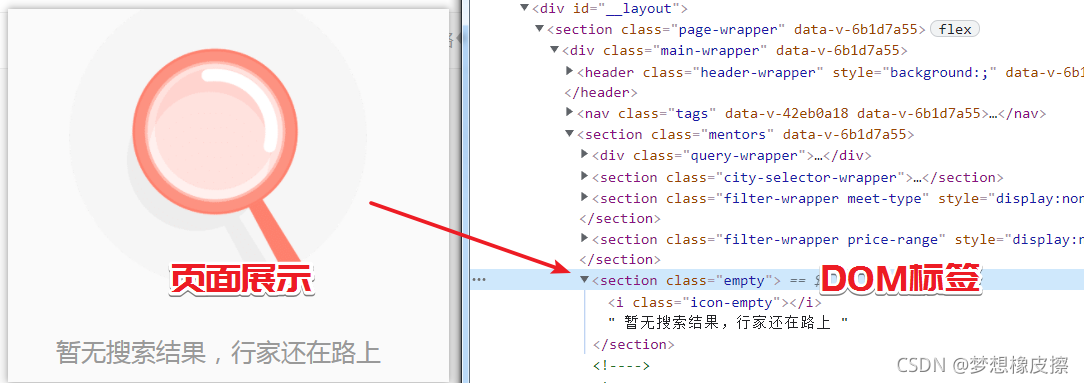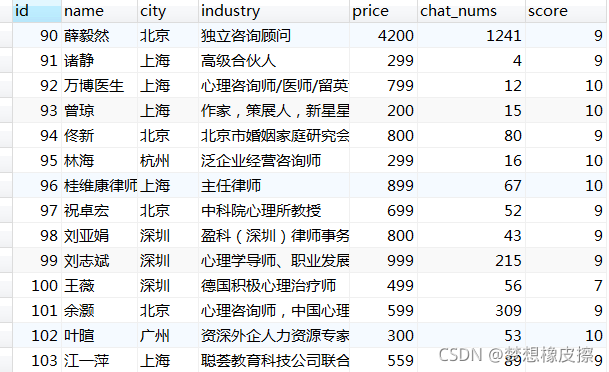您好,登錄后才能下訂單哦!
您好,登錄后才能下訂單哦!
如何用python進行scrapy管道學習爬取在行高手數據,針對這個問題,這篇文章詳細介紹了相對應的分析和解答,希望可以幫助更多想解決這個問題的小伙伴找到更簡單易行的方法。
本次采集的目標站點為:https://www.zaih.com/falcon/mentors,目標數據為在行高手數據。

本次數據保存到 MySQL 數據庫中,基于目標數據,設計表結構如下所示。

對比表結構,可以直接將 scrapy 中的 items.py 文件編寫完畢。
class ZaihangItem(scrapy.Item): # define the fields for your item here like: name = scrapy.Field() # 姓名 city = scrapy.Field() # 城市 industry = scrapy.Field() # 行業 price = scrapy.Field() # 價格 chat_nums = scrapy.Field() # 聊天人數 score = scrapy.Field() # 評分
項目的創建過程參考上一案例即可,本文直接從采集文件開發進行編寫,該文件為 zh.py。
本次目標數據分頁地址需要手動拼接,所以提前聲明一個實例變量(字段),該字段為 page,每次響應之后,判斷數據是否為空,如果不為空,則執行 +1 操作。
請求地址模板如下:
https://www.zaih.com/falcon/mentors?first_tag_id=479&first_tag_name=心理&page={}當頁碼超過最大頁數時,返回如下頁面狀態,所以數據為空狀態,只需要判斷 是否存在 class=empty 的 section 即可。

解析數據與數據清晰直接參考下述代碼即可。
import scrapy
from zaihang_spider.items import ZaihangItem
class ZhSpider(scrapy.Spider):
name = 'zh'
allowed_domains = ['www.zaih.com']
page = 1 # 起始頁碼
url_format = 'https://www.zaih.com/falcon/mentors?first_tag_id=479&first_tag_name=%E5%BF%83%E7%90%86&page={}' # 模板
start_urls = [url_format.format(page)]
def parse(self, response):
empty = response.css("section.empty") # 判斷數據是否為空
if len(empty) > 0:
return # 存在空標簽,直接返回
mentors = response.css(".mentor-board a") # 所有高手的超鏈接
for m in mentors:
item = ZaihangItem() # 實例化一個對象
name = m.css(".mentor-card__name::text").extract_first()
city = m.css(".mentor-card__location::text").extract_first()
industry = m.css(".mentor-card__title::text").extract_first()
price = self.replace_space(m.css(".mentor-card__price::text").extract_first())
chat_nums = self.replace_space(m.css(".mentor-card__number::text").extract()[0])
score = self.replace_space(m.css(".mentor-card__number::text").extract()[1])
# 格式化數據
item["name"] = name
item["city"] = city
item["industry"] = industry
item["price"] = price
item["chat_nums"] = chat_nums
item["score"] = score
yield item
# 再次生成一個請求
self.page += 1
next_url = format(self.url_format.format(self.page))
yield scrapy.Request(url=next_url, callback=self.parse)
def replace_space(self, in_str):
in_str = in_str.replace("\n", "").replace("\r", "").replace("¥", "")
return in_str.strip()開啟 settings.py 文件中的 ITEM_PIPELINES,注意類名有修改
ITEM_PIPELINES = {
'zaihang_spider.pipelines.ZaihangMySQLPipeline': 300,
}修改 pipelines.py 文件,使其能將數據保存到 MySQL 數據庫中
在下述代碼中,首先需要了解類方法 from_crawler,該方法是 __init__ 的一個代理,如果其存在,類被初始化時會被調用,并得到全局的 crawler,然后通過 crawler 就可以獲取 settings.py 中的各個配置項。
除此之外,還存在一個 from_settings 方法,一般在官方插件中也有應用,示例如下所示。
@classmethod
def from_settings(cls, settings):
host= settings.get('HOST')
return cls(host)
@classmethod
def from_crawler(cls, crawler):
# FIXME: for now, stats are only supported from this constructor
return cls.from_settings(crawler.settings)在編寫下述代碼前,需要提前在 settings.py 中寫好配置項。
settings.py 文件代碼
HOST = "127.0.0.1" PORT = 3306 USER = "root" PASSWORD = "123456" DB = "zaihang"
pipelines.py 文件代碼
import pymysql
class ZaihangMySQLPipeline:
def __init__(self, host, port, user, password, db):
self.host = host
self.port = port
self.user = user
self.password = password
self.db = db
self.conn = None
self.cursor = None
@classmethod
def from_crawler(cls, crawler):
return cls(
host=crawler.settings.get('HOST'),
port=crawler.settings.get('PORT'),
user=crawler.settings.get('USER'),
password=crawler.settings.get('PASSWORD'),
db=crawler.settings.get('DB')
)
def open_spider(self, spider):
self.conn = pymysql.connect(host=self.host, port=self.port, user=self.user, password=self.password, db=self.db)
def process_item(self, item, spider):
# print(item)
# 存儲到 MySQL
name = item["name"]
city = item["city"]
industry = item["industry"]
price = item["price"]
chat_nums = item["chat_nums"]
score = item["score"]
sql = "insert into users(name,city,industry,price,chat_nums,score) values ('%s','%s','%s',%.1f,%d,%.1f)" % (
name, city, industry, float(price), int(chat_nums), float(score))
print(sql)
self.cursor = self.conn.cursor() # 設置游標
try:
self.cursor.execute(sql) # 執行 sql
self.conn.commit()
except Exception as e:
print(e)
self.conn.rollback()
return item
def close_spider(self, spider):
self.cursor.close()
self.conn.close()管道文件中三個重要函數,分別是 open_spider,process_item,close_spider。
# 爬蟲開啟時執行,只執行一次 def open_spider(self, spider): # spider.name = "橡皮擦" # spider對象動態添加實例變量,可以在spider模塊中獲取該變量值,比如在 parse(self, response) 函數中通過self 獲取屬性 # 一些初始化動作 pass # 處理提取的數據,數據保存代碼編寫位置 def process_item(self, item, spider): pass # 爬蟲關閉時執行,只執行一次,如果爬蟲運行過程中發生異常崩潰,close_spider 不會執行 def close_spider(self, spider): # 關閉數據庫,釋放資源 pass

關于如何用python進行scrapy管道學習爬取在行高手數據問題的解答就分享到這里了,希望以上內容可以對大家有一定的幫助,如果你還有很多疑惑沒有解開,可以關注億速云行業資訊頻道了解更多相關知識。
免責聲明:本站發布的內容(圖片、視頻和文字)以原創、轉載和分享為主,文章觀點不代表本網站立場,如果涉及侵權請聯系站長郵箱:is@yisu.com進行舉報,并提供相關證據,一經查實,將立刻刪除涉嫌侵權內容。